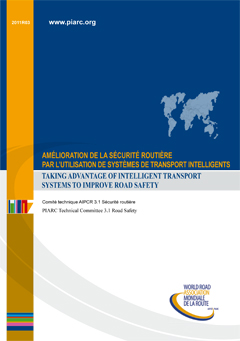Taking advantage of intelligent transport systems to improve road safety

Intelligent Transport Systems1 (ITS) have been used for more than 20 years. ITS is rapidly entering the marketplace and is likely to penetrate a greater part of the vehicle fleet in the next 10 - 15 years. Applied effectively, ITS can save lives, time, and money as well as reduce threats to our environment.
The general message is that ITS should be applied for easing the task of the driver: ITS will also reduce the driver's risk of being involved in a crash. But one has to be careful because some systems are not developped and implemented to reduce crashes and some systems are even expected to result in more crashes. Road authorities, as a major public stakeholder in ITS, are largely responsible for the safety aspects of ITS. Therefore, road authorities should increase research efforts, conduct pilots and invest in safety related areas of ITS.
Many systems suggest the use of multimodal transport and reduce travel times reducing consequently the number and seriousness of accidents, bottlenecks and pollution.
It is likely that the increased penetration of many in vehicle ITS systems will make using vehicles much more attractive than for instance, the use of public transport i.e. would have a negative safety effect due to modal shift (more traffic => the number of crashes increases). Some systems can also have a negative impact on some aspects of driving behaviour via behavioural adaptation.
The road authorities will continue to deploy their own ITS systems on the road networks. It is vital that systems, where the road authorities have the main responsibility, should be deployed in a co-ordinated manner by those authorities. This emphasises the need of common strategies and visions at least on a general level.
Continuous technology development and emergence of new solutions sets great challenges for the road authorities as systems become obsolete quite quickly. Nevertheless, the basic building blocks of the systems in the form of positioning, identification, real-time transport network status information, data communication interfaces and system architectures (how the systems look) are quite stable. For this reason, the road authorities should make investments in ITS without over concern for ageing technology components.
Universally ambitious road safety objectives mean that road authorities cannot achieve targets within their own budget frameworks, but need the additional fatality reduction brought about by vehicle-based systems. For this reason, the road authorities must use their influence to promote the roll-out of those vehicle-based systems which have high potential for improving safety.
Road Authorities can influence the implementation of all of these systems. For vehicle based systems, road authorities can put pressure on vehicle manufactures to include the systems in their vehicles as standard and they can influence governments to lower taxes on those systems. For the road systems road authorities can implement those systems at given locations where they are expected to have a high benefit. The same is the case with systems involving both road and vehicle technology.
Information sheet
- Date: 2011
- Author(s): Comité technique 3.1 Sécurité routière / Technical Committee 3.1 Road Safety
- Domain(s): Road Safety
- PIARC Ref.: 2011R03EN
- ISBN: 2-84060-233-4
- Number of pages: 179